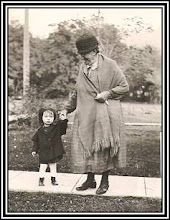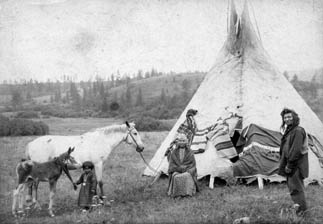Beverly writes, “when Herman was 14 (in 1910) Mathias announced to the family that he was going to the World’s Fair in Portland.” According to my research, however, there was no World’s Fair in Portland in 1910. There was one in 1905, and perhaps this is the one Matthias attended.  Train station on the way to Portland, Oregon, circa 1905.
Train station on the way to Portland, Oregon, circa 1905.
 Train station on the way to Portland, Oregon, circa 1905.
Train station on the way to Portland, Oregon, circa 1905.“He left and never returned and eventually settled in San Francisco,” remembers my mom. In 1906, the city of San Francisco was hit by a devastating earthquake that leveled most of the city. According to my mom, Mathias went to San Francisco to help rebuild it. “A carpenter and cabinet maker by trade before his immigration to the U.S., he may have thought there would be work to do in rebuilding San Francisco after the earthquake.”


Some of the thousands of itinerant carpenters who moved to San Francisco to help rebuild the devastated city after the quake.
“The family was never together again. Eventually Grandmother got a divorce but continued to send him financial support. For Otto and Herman this meant the end to their schooling so that they could work on the farm. I remember my father saying that he would never again walk behind a horse and plow! He had more than enough as a boy!”
My grandpa Herman also writes of the day his father abandoned the family. “In 1910 our father went to Portland to the fair and then went on to San Francisco and never returned. He and mother were later divorced. Rupert also left his family and joined father and they spent their time in California until father died in 1925. Rupert returned to Spokane where he died in 1941. Florian died at Juliaetta in 1940.”
Alone with three children, thousands of miles from her beloved Austrian Alps, and with no money to return, Aloisia settled down to raise her family and do the best she could to get on with her life. Her daughter Ida followed in her older brothers’ footsteps as a hard-working and determined girl. She did many chores and when she got a little older she got a job at the cannery in Juliaetta. After spending some time at Spokane Business College, she returned to help her brothers with their new telephone company. Ida became the first telephone operator for the new Potlatch Telephone Company and worked for the company until she died in 1951 of cancer.
In 1915, Otto worked at the Kendrick Auto Company in nearby Kendrick, Idaho. That same year, Otto and Herman bought the Potlatch Telephone Company and the Interstate Telephone Company and combined them into the Potlatch Telephone Company. They built this small company into a successful business that provided them both with a comfortable living for the rest of their lives. Both were natural tinkerers, very mechanical, and loved cars and motorcycles. Herman always drove a nice car, and he always paid for everything with cash, a vestige of his lean early years and his unwillingness to fall into debt.

 Kendrick, Idaho, circa 1910.
Kendrick, Idaho, circa 1910.During the war, Otto and Herman received draft numbers but were not drafted. There was a lot of anti-German sentiment in the U.S. and this included Idaho. According to my great-uncle, Herman’s brother Otto, a German church in Juliaetta was vandalized and German-speaking Americans were suspect as spies. Nevertheless, Herman went to work at the Bremerton Navy Yard until the war was over, where he built ships. During his tenure at the Navy Yard, he sawed off his pinky in a work accident. Growing up, I never tired of looking at his stump, which he would wiggle accommodatingly for my entertainment.
 Bremerton Navy Ship Yard, Bremerton, Washington, where Herman Schupfer worked building ships during World War One.
Bremerton Navy Ship Yard, Bremerton, Washington, where Herman Schupfer worked building ships during World War One.Herman worked as a mechanic, a driver, and with the telephone company. He trucked gasoline in oil barrels over the dangerous roads of north Idaho. At the time, gas sold for twenty cents a gallon. He was one of the first men in northern Idaho to own a motorcycle when he bought a 1908 single-cylinder Indian, which he later traded on a two-cylinder Indian. Otto also bought a motorcycle, a twin-cylinder Pope, and the brothers used the bikes to make the rounds and check the telephone lines between Kendrick and Spalding and Kendrick and Moscow.

A 1908 Indian motorcycle, above.
After 1922, Herman and Otto worked full-time on the telephone business. Herman went to Huntington Beach, California in 1922 and worked for the telephone company there, picking up as much as he could about running a phone company. In 1924 he returned and concentrated on building the Potlatch Telephone Company.
He also worked for Washington Water Power as a local manager in Kendrick. In 1920, Herman and Otto bought a movie theater in Kendrick. First, they showed weekend shows of silent movies. It became the main entertainment for farmers and people for miles around, and Saturday nights in Kendrick were lively, with many people spending the evening eating dinner at Bert’s Café and then seeing a movie and maybe having a milkshake afterwards. Shortly after, talkies were invented. The first talkies were large discs that had to be synchronized with the film. If the record skipped or malfunctioned, the sound did not match the action on the screen.

This is what the early sound projectors looked like. Before the theater was turned into a carpet store, but after it was closed down, I poked around in the projection room and saw this same set-up.
Eventually, the sound strip was put directly onto the film, eliminating this problem. The theater stayed open for fifty years. The last show that played there, according to my grandpa, was ‘Mary Poppins’ but I remember going to shows into the early seventies. When I got to go into the Kendrick Theater without paying, or got to go up to the projection room, I felt like as big a celebrity as the President of the United States! That’s right—my grandpa owns the theater.
What must Aloisia have thought as she watched her children grow up and become successful businessmen? All three of her children were so American! They moved in this strange world as easily as everyone else, while she had to watch and wonder much of the time. After Otto’s marriage, he and his wife Josephine moved onto the homestead, and Aloisia moved into a small home in Kendrick. The home is still there, and Otto continued to live on the homestead until he passed away in the late seventies.
 This photo, sent to me back in the mid-seventies by Uncle Otto Schupfer (Aloisia's oldest son and my great-uncle) shows Otto on the porch and his wife Josephine in the yard.
This photo, sent to me back in the mid-seventies by Uncle Otto Schupfer (Aloisia's oldest son and my great-uncle) shows Otto on the porch and his wife Josephine in the yard.



1 comment:
Thank you for this blog.
Very interesting and wonderful.
It helps imagine the life of people left our region here in Austria/Styria for better life.
Irmgard Seebacher-Soelkner, born Schladming.
Post a Comment